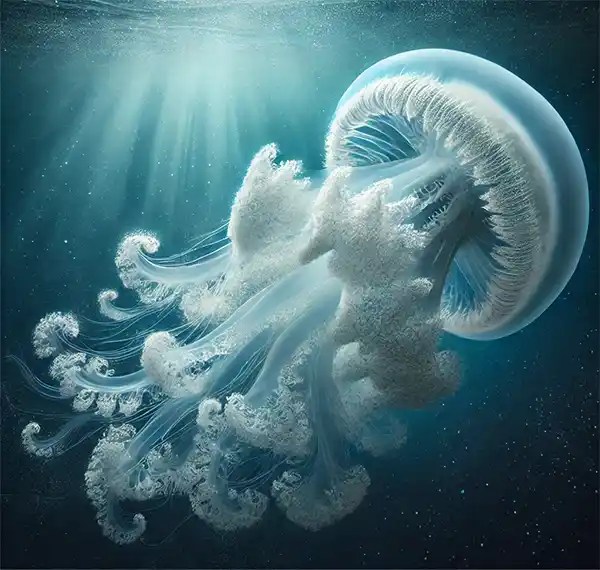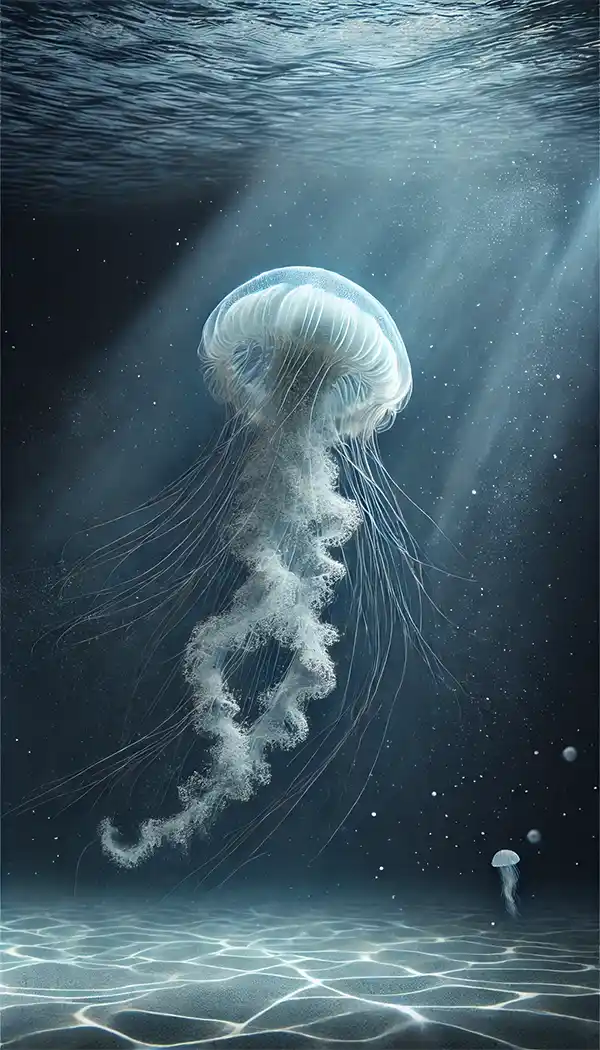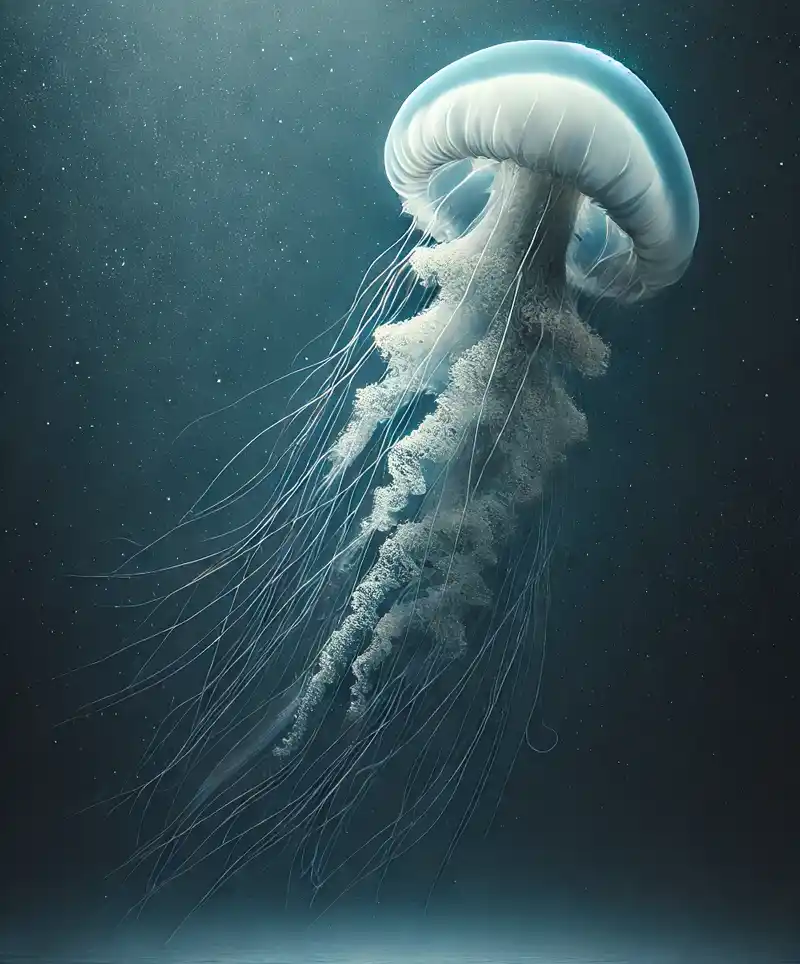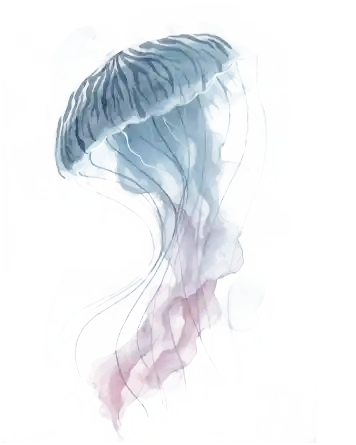Celebrating the Ocean’s Most Mysterious Drifters
Every year on November 3rd, we celebrate World Jellyfish Day, honoring one of the ocean's most peculiar residents. Despite their brainless nature, jellyfish have managed to outlive the dinosaurs, travel across oceans, and even make their way into art and mythology. World Jellyfish Day is a chance to marvel at their curious nature, their mesmerizing forms, and their mysterious role in the ocean’s ecosystem.
Jellyfish have been around for over 500 million years, making them some of the oldest living creatures on Earth. And here’s the kicker—they haven’t changed much in all that time! Why mess with a good thing, right? Jellyfish are part of the phylum Cnidaria, which includes sea anemones and corals, their equally fascinating (and often stationary) cousins. They come in thousands of species and an astonishing array of colors, shapes, and sizes.
 The jellyfish body plan is as minimalistic as it gets: no brain, no heart, no bones, no problem. Their “body” is primarily made up of a bell-shaped, gelatinous mass, with tentacles extending from the edges. Despite their apparent simplicity, they’ve got some complex tricks up their nonexistent sleeves. Equipped with specialized cells called nematocysts, jellyfish can deliver a powerful sting, giving them a rather effective self-defense mechanism—and a way to catch prey without needing to chase it down.
The jellyfish body plan is as minimalistic as it gets: no brain, no heart, no bones, no problem. Their “body” is primarily made up of a bell-shaped, gelatinous mass, with tentacles extending from the edges. Despite their apparent simplicity, they’ve got some complex tricks up their nonexistent sleeves. Equipped with specialized cells called nematocysts, jellyfish can deliver a powerful sting, giving them a rather effective self-defense mechanism—and a way to catch prey without needing to chase it down.
From Tiny Polyp to Flowing Bell
Jellyfish go through one of the more unusual life cycles in the animal kingdom, undergoing multiple phases before reaching the drifting beauty we recognize. They start as free-swimming larvae, which eventually attach to a hard surface and develop into a stationary polyp. After some time, the polyp begins a process called strobilation, during which it produces little segments that pop off and become individual baby jellyfish (known as ephyrae). These baby jellies grow into the full-fledged adult form, known as the medusa.
And in case that wasn’t enough, some species, like the Turritopsis dohrnii, are famously capable of reverting back to their polyp stage, essentially resetting their life cycle and granting them the title of “immortal jellyfish.” If that sounds like something out of science fiction, well, so is most of what jellyfish do!
A Diverse and Drifting Bunch
Jellyfish come in a variety of types, from the nearly microscopic to the stunningly massive, each species with its own unique qualities. Here’s a look at a few of the ocean’s most famous jellies:
-
Moon Jellyfish: Perhaps the most well-known, with its translucent bell and short, frilly tentacles, the moon jellyfish is gentle (by jellyfish standards) and often found near coastlines.
-
Box Jellyfish: Not one to mess around, this jellyfish has venom so potent that it’s considered one of the most dangerous animals in the ocean. Known for its cube-shaped bell, the box jellyfish is as deadly as it is fascinating.
-
Lion’s Mane Jellyfish: The largest jellyfish species, its tentacles can grow longer than a blue whale. Despite its intimidating size, it mostly sticks to chilly northern waters.
-
Irukandji Jellyfish: Measuring just about a cubic centimeter, this tiny jelly packs a punch powerful enough to send a full-grown human to the hospital. Nature’s reminder that size isn’t everything.
-
Sea Nettle: A colorful resident of the Atlantic and Pacific, the sea nettle has long, flowing tentacles that pack a sting but are relatively harmless to humans.
Handle with Care
If there’s one thing people think of when they hear “jellyfish,” it’s the sting. While not all jellyfish are dangerous to humans, some can indeed pack a punch that can ruin even the sunniest beach day. Jellyfish stings occur when those specialized cells, nematocysts, inject venom into the skin. It’s not personal—these cells fire automatically when touched.
 So, what’s the best way to avoid a jellyfish sting? Quite simply, keep a respectful distance. And if you happen to spot a jellyfish washed up on the shore, resist the urge to touch it. Even a jellyfish on dry land can still sting if you brush against its tentacles. Should the worst happen, skip the myths—no need for vinegar, and definitely don’t resort to…ahem, alternative remedies. Instead, rinse the area with saltwater and seek medical attention if needed.
So, what’s the best way to avoid a jellyfish sting? Quite simply, keep a respectful distance. And if you happen to spot a jellyfish washed up on the shore, resist the urge to touch it. Even a jellyfish on dry land can still sting if you brush against its tentacles. Should the worst happen, skip the myths—no need for vinegar, and definitely don’t resort to…ahem, alternative remedies. Instead, rinse the area with saltwater and seek medical attention if needed.
Jellyfish in Ecosystems
Jellyfish play a surprisingly important role in marine ecosystems. For starters, they’re an essential part of the food web, providing a source of nutrition for a variety of animals, from sea turtles to larger fish species. Their jelly-like bodies might seem insubstantial, but they’re packed with nutrients that these predators rely on.
Jellyfish are also efficient ocean travelers, drifting with currents and tides. In some regions, jellyfish blooms—mass gatherings of jellyfish—are so dense that they can be seen from space. While these blooms can cause issues, clogging fishing nets or blocking power plant intakes, they’re also a natural part of the ocean’s rhythm. The truth is, jellyfish are a reminder that even creatures without a brain can have a purpose (perhaps there’s a metaphor in there for us all).
Fun Facts About Jellyfish
-
Older Than Dinosaurs: Jellyfish have been swimming around for more than half a billion years, putting them in the "ancient survivor" category alongside sharks and horseshoe crabs.
-
Jellyfish Blooms Are Massive: When conditions are just right, jellyfish can reproduce in enormous numbers, creating blooms that stretch for miles and can be seen from satellites. Imagine your beach day invaded by a jelly parade!
-
Not All Are True Jellies: Creatures like the Portuguese Man o’ War are often mistaken for jellyfish but belong to a different group known as siphonophores. They might look similar, but they’re actually colonies of organisms working together. Talk about teamwork!
-
No Brain, No Problem: Jellyfish don’t have brains, yet they still manage to eat, reproduce, and occasionally ruin a surfer’s day. Their movements are controlled by a decentralized nerve net, which allows them to respond to their environment without needing any higher processing.
As strange as it sounds, jellyfish are finding new roles in human life beyond the aquarium. Scientists are studying jellyfish to learn more about longevity (remember that “immortal” jellyfish?) and are even exploring ways to use jellyfish proteins in medical research. The jellyfish’s unique makeup is inspiring scientists across fields, from biomedicine to bioengineering.
Plus, jellyfish are starting to appear on restaurant menus, especially in East Asian cuisine, where certain species are enjoyed as a delicacy. The texture? Chewy, with a crunch that’s hard to describe—probably a little different than your typical seafood.
How to Celebrate World Jellyfish Day
Here are a few ways you can get in the spirit of World Jellyfish Day:
-
Visit an Aquarium: Many aquariums feature breathtaking jellyfish exhibits where you can see these graceful creatures up close. Watching them drift in their tanks is one of the most hypnotic experiences you’ll find.
-
Learn More About Ocean Conservation: Jellyfish are resilient, but their ecosystems are not. Learning about conservation and supporting marine protection efforts is one of the best ways to celebrate these ancient creatures.
-
Get Crafty: Feeling creative? Try making jellyfish-inspired crafts with kids or friends. With a little paper, some streamers, and maybe a splash of glitter, you’ll have your very own jellyfish that won’t sting.
-
Dive Into the Science: Read up on the fascinating world of jellyfish biology. There’s so much to discover, from their unique anatomy to their role in the marine food chain.
World Jellyfish Day is a time to celebrate these quirky, captivating, and often misunderstood creatures. They might not have a brain, but they’ve figured out a way to thrive in nearly every ocean on Earth, from the warm, shallow shores to the dark, icy depths. Their silent, rhythmic pulsing and translucent beauty remind us of the mysteries that still lie beneath the waves. So, whether you’re marveling at them in an aquarium or spotting one in the wild (from a safe distance!), jellyfish are here to remind us of the ocean’s endless wonders—no brain required.
Please Share our Content






 The jellyfish body plan is as minimalistic as it gets: no brain, no heart, no bones, no problem. Their “body” is primarily made up of a bell-shaped, gelatinous mass, with tentacles extending from the edges. Despite their apparent simplicity, they’ve got some complex tricks up their nonexistent sleeves. Equipped with specialized cells called nematocysts, jellyfish can deliver a powerful sting, giving them a rather effective self-defense mechanism—and a way to catch prey without needing to chase it down.
The jellyfish body plan is as minimalistic as it gets: no brain, no heart, no bones, no problem. Their “body” is primarily made up of a bell-shaped, gelatinous mass, with tentacles extending from the edges. Despite their apparent simplicity, they’ve got some complex tricks up their nonexistent sleeves. Equipped with specialized cells called nematocysts, jellyfish can deliver a powerful sting, giving them a rather effective self-defense mechanism—and a way to catch prey without needing to chase it down. So, what’s the best way to avoid a jellyfish sting? Quite simply, keep a respectful distance. And if you happen to spot a jellyfish washed up on the shore, resist the urge to touch it. Even a jellyfish on dry land can still sting if you brush against its tentacles. Should the worst happen, skip the myths—no need for vinegar, and definitely don’t resort to…ahem, alternative remedies. Instead, rinse the area with saltwater and seek medical attention if needed.
So, what’s the best way to avoid a jellyfish sting? Quite simply, keep a respectful distance. And if you happen to spot a jellyfish washed up on the shore, resist the urge to touch it. Even a jellyfish on dry land can still sting if you brush against its tentacles. Should the worst happen, skip the myths—no need for vinegar, and definitely don’t resort to…ahem, alternative remedies. Instead, rinse the area with saltwater and seek medical attention if needed.








 "Sláinte!" is a traditional Irish expression used as a toast, equivalent to "Cheers!" in English.
"Sláinte!" is a traditional Irish expression used as a toast, equivalent to "Cheers!" in English.